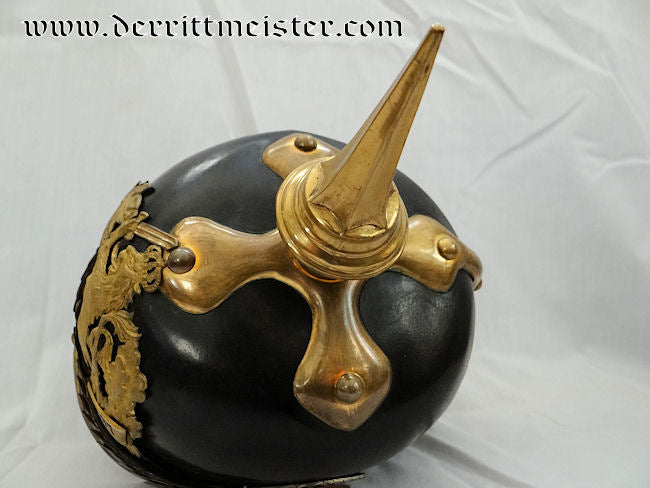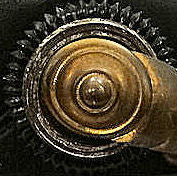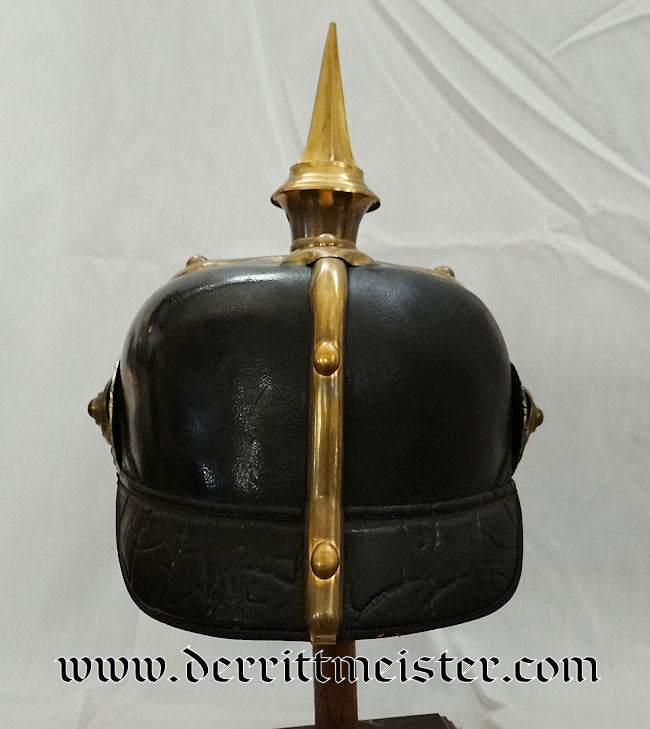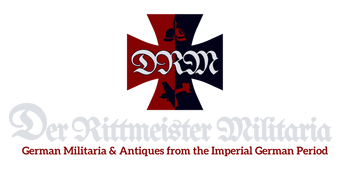Hesse Darmstadt Pickelhaube / Spiked Helmet for Officer in Infanterie Rgt 117
- Regular price
- $8,295.00
- Sale price
- $8,295.00
- Regular price
SKU: 04-674
This is a very tasty Infanterie-Regiment Nr 117 officer’s pickelhaube from the Grand Duchy of Hesse-Darmstadt. The regiment was officially known as Infanterie-Leib-Regiment Großherzogin (3. Großherzogl. Hessisches) Nr 117. Although it was numbered as Hesse-Darmstadt’s THIRD infantry regiment, it actually was the SECOND-oldest, and also held “Leib” (life) status. The proud old regiment was founded in 1697. It was garrisoned at Mainz and attached to the XVIII. Armeekorps.
This very desirable spiked helmet possesses a marvelous, leather body of the highest quality and condition. Despite a small mark or two, its overall condition is amazing. The leather is smooth as the proverbial baby’s bottom. Some slight settling (often seen in Bavarian helmets) shows at its top due to the cruciform weight. The Bavarian and Hesse-Darmstadt cruciform were much larger than the bases used on Prussian helmets, for example. Its wappen is made of very fine, frosted gold, which adds a lot of style. It displays a rampant, Hesse-Darmstadt Lion brandishing a sword in its right forepaw, surrounded by a wreath on both sides. The dates 1697 and 1897 appear on the wreath’s two halves. [1897 was an important year in Imperial German headdresses’ design. Prior to that year, all headdresses displayed only the state’s kokarde from which the soldier originated. Beginning in 1897, a Reich’s kokarde was added to that of the state. Pickelhauben and kugelhelme had their states’ kokarden moved from their right sides (from the wearers’ perspectives), to their LEFT. Thenceforth, their Reich’s kokarden appeared on their right sides. This was also the case with Schirmmützen and mützen. The other headdress forms, such as busbies, tschapkas, and the tschakos, displayed only the Reich’s kokarde on the right side]. The twin dates confirm that the helmet was produced during (or after) 1897. [Another important distinction for 1897 was that Hannover, Braunschweig, and Nassau, which had been annexed by Prussia after their defeat in the 1866 Austro-Prussian War, were allowed to again display bandeaux celebrating Napoleonic War battle honors. This allowed these states to differentiate themselves from other Prussian line-regiments by noting their previous service and the famous battles in which they had bravely fought].
All of the helmet’s other furniture is also gilt-toned. The (flat) chin scales, trim, cruciform, spike, etc., are all gilt. [Please note: the cruciform sports bolts rather than officers’ stars. This is a major difference among Hesse-Darmstadt helmets, which makes it a bit more difficult for a new collector to differentiate between an officer’s helmet and that of a One-Year-Volunteer. Also note that spikes and the trichters (when worn) are fluted]. The exterior’s final detail concerns Hesse-Darmstadt’s red and white state’s kokarde, which displays a very different pattern from that found on typical Prussian helmets. I find it to be a very elegant kokarde, one that also can be seen on Württemberg’s, Baden’s, and (sometimes) Saxony’s helmets.
Moving to the helmet’s interior, we see a high-quality, lightly-used, leather sweatband. The light-beige silk liner does display some “runs” (shredding). EVERY piece of original hardware is in place under the silk liner, including a unique wappen-mounting system. Also, since we see no double holes, we are assured that it is a totally original helmet.
This is a very rare and desirable spiked helmet in the very best of condition.
This very desirable spiked helmet possesses a marvelous, leather body of the highest quality and condition. Despite a small mark or two, its overall condition is amazing. The leather is smooth as the proverbial baby’s bottom. Some slight settling (often seen in Bavarian helmets) shows at its top due to the cruciform weight. The Bavarian and Hesse-Darmstadt cruciform were much larger than the bases used on Prussian helmets, for example. Its wappen is made of very fine, frosted gold, which adds a lot of style. It displays a rampant, Hesse-Darmstadt Lion brandishing a sword in its right forepaw, surrounded by a wreath on both sides. The dates 1697 and 1897 appear on the wreath’s two halves. [1897 was an important year in Imperial German headdresses’ design. Prior to that year, all headdresses displayed only the state’s kokarde from which the soldier originated. Beginning in 1897, a Reich’s kokarde was added to that of the state. Pickelhauben and kugelhelme had their states’ kokarden moved from their right sides (from the wearers’ perspectives), to their LEFT. Thenceforth, their Reich’s kokarden appeared on their right sides. This was also the case with Schirmmützen and mützen. The other headdress forms, such as busbies, tschapkas, and the tschakos, displayed only the Reich’s kokarde on the right side]. The twin dates confirm that the helmet was produced during (or after) 1897. [Another important distinction for 1897 was that Hannover, Braunschweig, and Nassau, which had been annexed by Prussia after their defeat in the 1866 Austro-Prussian War, were allowed to again display bandeaux celebrating Napoleonic War battle honors. This allowed these states to differentiate themselves from other Prussian line-regiments by noting their previous service and the famous battles in which they had bravely fought].
All of the helmet’s other furniture is also gilt-toned. The (flat) chin scales, trim, cruciform, spike, etc., are all gilt. [Please note: the cruciform sports bolts rather than officers’ stars. This is a major difference among Hesse-Darmstadt helmets, which makes it a bit more difficult for a new collector to differentiate between an officer’s helmet and that of a One-Year-Volunteer. Also note that spikes and the trichters (when worn) are fluted]. The exterior’s final detail concerns Hesse-Darmstadt’s red and white state’s kokarde, which displays a very different pattern from that found on typical Prussian helmets. I find it to be a very elegant kokarde, one that also can be seen on Württemberg’s, Baden’s, and (sometimes) Saxony’s helmets.
Moving to the helmet’s interior, we see a high-quality, lightly-used, leather sweatband. The light-beige silk liner does display some “runs” (shredding). EVERY piece of original hardware is in place under the silk liner, including a unique wappen-mounting system. Also, since we see no double holes, we are assured that it is a totally original helmet.
This is a very rare and desirable spiked helmet in the very best of condition.



















